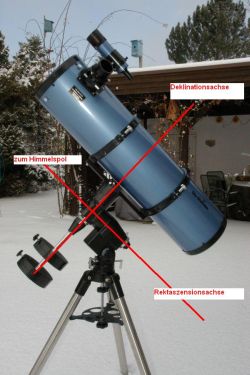The equatorial mount
|
This astronomical mount is known as an equatorial, or occasionally a parallactic, mount. It is almost a must for meaningful astronomical observation and available in two different versions:
These mounts look very different, but the principle is the same. Each mount consists of two slewable axes.
The horizontal plane of the telescope mount can be adjusted to match the latitude at the observation site. The Pole Star has an angular elevation which exactly corresponds to the geographical latitude here. These two axes are responsible for the co-ordinate system used for the sky. Imagine the celestial coordinate system as simply a projection onto the celestial sphere. It consists of many curved vertical and horizontal lines which together form the intersections of many ‘boxes’. Dec indicates the altitude of an object above the celestial equator in a scale going up to 90°. The RA coordinates are responsible for the changing hour angle, the celestial equivalent to terrestrial longitude. This is measured eastward, in hours and minutes, from its zero point in the vernal equinox in the constellation of Pisces. When you have located a specific object in your telescope, you can now follow its coordinates on a planisphere (rotatable star map). Dec is always fixed and corresponds to that specified on the planisphere (e.g. 50° North). The RA, however, can be adjusted and you can set the hour angle on a rotating coordinate ring. You can rotate the RA scale on the telescope mount until the indication corresponds to the star map. Now you can just pick out any object from the star map and adjust the mount according to the coordinates of the object. Once the equatorially mounted telescope is aligned on Polaris, you can point the mount (and hence the telescope) at any object you want to observe. You have now only to compensate for Earth’s rotation by using the RA slow motion knob to keep an object in the centre of the field of view. You do not need to do anything about the declination. Everything becomes much easier with motors on the axes, as then you do not even have to compensate for the Earth's rotation manually, but can simply let the motors do the work. In general, there is also a control box provided with which you can make any corrections needed. When used for astrophotography, the mount must be somewhat more precisely set up than simple alignment on Polaris. This is because the North Celestial Pole is not located precisely at Polaris, but about 0.5° away. This will lead slightly inaccurate tracking if not aligned on correctly. The best way to align on the North Celestial Pole with high precision is to use a polar finder scope. This is included as an option with many mounts. |
|

